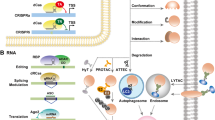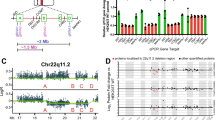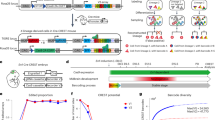Abstract
We provide a protocol for generating forebrain structures in vivo from mouse embryonic stem cells (ESCs) via neural blastocyst complementation (NBC). We developed this protocol for studies of development and function of specific forebrain regions, including the cerebral cortex and hippocampus. We describe a complete workflow, from methods for modifying a given genomic locus in ESCs via CRISPR–Cas9-mediated editing to the generation of mouse chimeras with ESC-reconstituted forebrain regions that can be directly analyzed. The procedure begins with genetic editing of mouse ESCs via CRISPR–Cas9, which can be accomplished in ~4–8 weeks. We provide protocols to achieve fluorescent labeling of ESCs in ~2–3 weeks, which allows tracing of the injected, ESC-derived donor cells in chimeras generated via NBC. Once modified ESCs are ready, NBC chimeras are generated in ~3 weeks via injection of ESCs into genetically programmed blastocysts that are subsequently transferred into pseudo-pregnant fosters. Our in vivo brain organogenesis platform is efficient, allowing functional and systematic analysis of genes and other genomic factors in as little as 3 months, in the context of a whole organism.
This is a preview of subscription content, access via your institution
Access options
Access Nature and 54 other Nature Portfolio journals
Get Nature+, our best-value online-access subscription
$29.99 / 30 days
cancel any time
Subscribe to this journal
Receive 12 print issues and online access
$259.00 per year
only $21.58 per issue
Buy this article
- Purchase on Springer Link
- Instant access to full article PDF
Prices may be subject to local taxes which are calculated during checkout









Similar content being viewed by others
Data availability
All data referred to or analyzed are included in Chang et al., Nature (2018): https://doi.org/10.1038/s41586-018-0586-0
References
Martin, G. R. Isolation of a pluripotent cell line from early mouse embryos cultured in medium conditioned by teratocarcinoma stem cells. Proc. Natl Acad. Sci. USA 78, 7634–7638 (1981).
Evans, M. J. & Kaufman, M. H. Establishment in culture of pluripotential cells from mouse embryos. Nature 292, 154–156 (1981).
Bradley, A., Evans, M., Kaufman, M. H. & Robertson, E. Formation of germ-line chimaeras from embryo-derived teratocarcinoma cell lines. Nature 309, 255–256 (1984).
Miura, T., Mattson, M. P. & Rao, M. S. Cellular lifespan and senescence signaling in embryonic stem cells. Aging Cell 3, 333–343 (2004).
Bradley, A., Hasty, P., Davis, A. & Ramirez-Solis, R. Modifying the mouse: design and desire. Biotechnology 10, 534–539 (1992).
Chang, A. N. et al. Neural blastocyst complementation enables mouse forebrain organogenesis. Nature 563, 126–130 (2018).
Kobayashi, T. et al. Generation of rat pancreas in mouse by interspecific blastocyst injection of pluripotent stem cells. Cell 142, 787–799 (2010).
Chen, J., Lansford, R., Stewart, V., Young, F. & Alt, F. W. RAG-2-deficient blastocyst complementation: an assay of gene function in lymphocyte development. Proc. Natl Acad. Sci. USA 90, 4528–4532 (1993).
Chen, J. et al. Generation of normal lymphocyte populations by Rb-deficient embryonic stem cells. Curr. Biol. 3, 405–413 (1993).
Usui, J. et al. Generation of kidney from pluripotent stem cells via blastocyst complementation. Am. J. Pathol. 180, 2417–2426 (2012).
Liégeois, N. J., Horner, J. W. & DePinho, R. A. Lens complementation system for the genetic analysis of growth, differentiation, and apoptosis in vivo. Proc. Natl Acad. Sci. USA 93, 1303–1307 (1996).
Stanger, B. Z., Tanaka, A. J. & Melton, D. A. Organ size is limited by the number of embryonic progenitor cells in the pancreas but not the liver. Nature 445, 886–891 (2007).
Wu, J. et al. Stem cells and interspecies chimaeras. Nature 540, 51–59 (2016).
Wu, J. et al. Interspecies chimerism with mammalian pluripotent stem cells. Cell 168, 473–486 (2017).
Gorski, J. A. et al. Cortical excitatory neurons and glia, but not GABAergic neurons, are produced in the Emx1-expressing lineage. J. Neurosci. 22, 6309–6314 (2002).
Behringer, R., Gertsenstein, M., Nagy, K. V. & Nagy, A. Manipulating the Mouse Embryo: A Laboratory Manual (Cold Spring Harbor Laboratory Press, 2014).
Conner, D. A. Mouse embryo fibroblast (MEF) feeder cell preparation. Curr. Protoc. Mol. Biol. 23.23.2 (2001).
Ran, F. A. et al. Genome engineering using the CRISPR–Cas9 system. Nat. Protoc. 8, 2281–2308 (2013).
Conner, D. A. Mouse embryonic stem (ES) cell culture. Curr. Protoc. Mol. Biol. 23.23.3 (2001).
Yang, H., Wang, H. & Jaenisch, R. Generating genetically modified mice using CRISPR/Cas-mediated genome engineering. Nat. Protoc. 9, 1956–1968 (2014).
Brown, T. Southern blotting. Curr. Protoc. Immunol. 10.10.6A (2001).
Ryder, E. et al. Molecular characterization of mutant mouse strains generated from the EUCOMM/KOMP-CSD ES cell resource. Mamm. Genome 24, 286–294 (2013).
Kutner, R. H., Zhang, X.-Y. & Reiser, J. Production, concentration and titration of pseudotyped HIV-1-based lentiviral vectors. Nat. Protoc. 4, 495–505 (2009).
Nissen, S. B. et al. Four simple rules that are sufficient to generate the mammalian blastocyst. PLoS Biol. 15, e2000737 (2017).
Lois, C., Hong, E. J., Pease, S., Brown, E. J. & Baltimore, D. Germline transmission and tissue-specific expression of transgenes delivered by lentiviral vectors. Science 295, 868–872 (2002).
Acknowledgements
We thank members of the Alt and Schwer labs and D. Laird for discussions, P.-Y. Huang for help with blastocyst injections and H.-L. Cheng for advice and help with ESC culture. This work was supported by the Howard Hughes Medical Institute, the Boston Children’s Hospital (BCH) Department of Medicine (DOM) Support Fund, the BCH DOM Anderson Porter Fund, a major grant from the Charles H. Hood Foundation (to F.W.A), and a generous gift from the Dabbiere family (to B.S.). B.S. is a Kimmel Scholar of the Sidney Kimmel Foundation and is supported by the University of California, San Francisco (UCSF) Brain Tumor SPORE Career Development Program, the American Cancer Society, the UCSF Program for Breakthrough Biomedical Research (which is partially funded by the Sandler Foundation), the Andrew McDonough B+ Foundation, the Shurl and Kay Curci Foundation and a Martin D. Abeloff V Scholar Award of the V Foundation for Cancer Research. B.S. holds the Suzanne Marie Haderle and Robert Vincent Haderle Endowed Chair at UCSF. H.-Q.D. is a fellow of the Cancer Research Institute of New York. F.W.A. is an Investigator of the Howard Hughes Medical Institute.
Author information
Authors and Affiliations
Contributions
A.N.C., H.-Q.D., Z.L., B.S., and F.W.A. designed the study. A.N.C., H.-Q.D., Z.L., B.A., A.A.P., and B.S. performed experiments. A.M.C.-W. performed NBC injections and related mouse work. B.S. and F.W.A. supervised the research. All authors contributed to the writing of the manuscript.
Corresponding authors
Ethics declarations
Competing interests
The authors declare no competing interests.
Additional information
Peer review information Nature Protocols thanks Harold Cremer, Lauryl Nutter and the other, anonymous, reviewer(s) for their contribution to the peer review of this work.
Publisher’s note Springer Nature remains neutral with regard to jurisdictional claims in published maps and institutional affiliations.
Related links
Key references using this protocol
Chang, A. N. et al. Nature 563, 126–130 (2018): https://doi.org/10.1038/s41586-018-0586-0
Key data used in this protocol
Chang, A. N. et al. Nature 563, 126–130 (2018): https://doi.org/10.1038/s41586-018-0586-0
Supplementary information
Supplementary Video 1
Dissection of uterine horns.
Supplementary Video 2
Flushing of uterine horns for embryo collection.
Supplementary Video 3
Pulling and blunting the transfer pipette.
Supplementary Video 4
Cutting the microinjection needle after pulling.
Supplementary Video 5
Injection of blastocysts.
Rights and permissions
About this article
Cite this article
Dai, HQ., Liang, Z., Chang, A.N. et al. Direct analysis of brain phenotypes via neural blastocyst complementation. Nat Protoc 15, 3154–3181 (2020). https://doi.org/10.1038/s41596-020-0364-y
Received:
Accepted:
Published:
Issue Date:
DOI: https://doi.org/10.1038/s41596-020-0364-y
This article is cited by
Comments
By submitting a comment you agree to abide by our Terms and Community Guidelines. If you find something abusive or that does not comply with our terms or guidelines please flag it as inappropriate.



